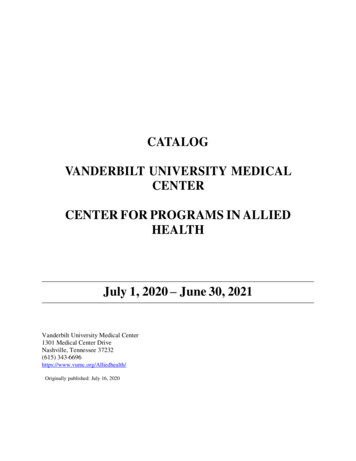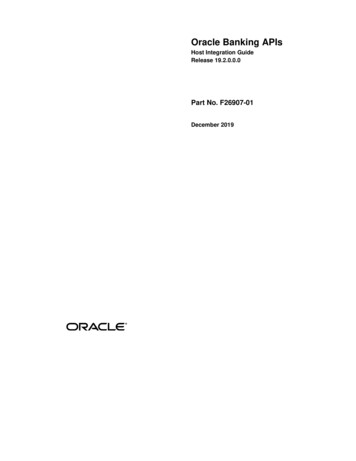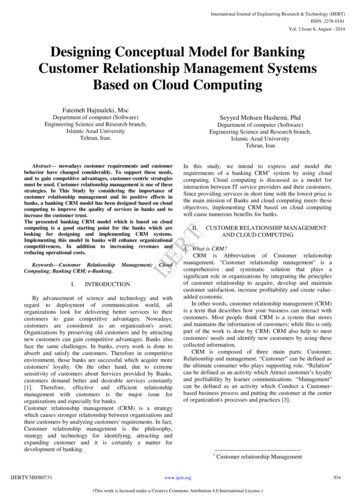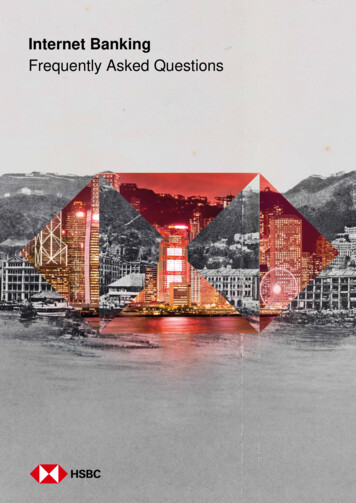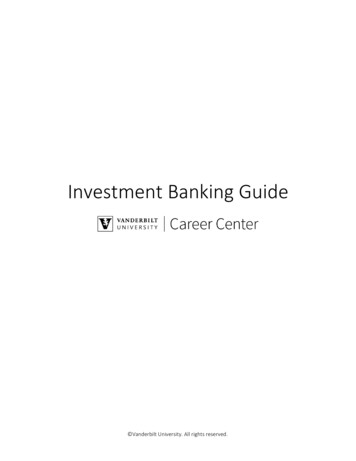
Transcription
Investment Banking Guide Vanderbilt University. All rights reserved.
2INTRODUCTION & ACKNOWLEDGEMENTAre you considering a career in investment banking? This guide will help you learnabout the industry, develop an understanding of the recruitment process, and provideyou with a plethora of resources for effective interview preparation.Filled with guidance and advice for successful investment banking recruiting, thisguidebook will help you: Comprehend the investment banking industry Understand how to navigate the recruitment process Develop a strategy for behavioral and technical interview preparation Obtain practical insights on the power and influence of networking Explore numerous resources to facilitate self-learningThis project would not have been possible without the time and support of Vanderbiltstudent Ashlyn Dong. Thank you for your significant efforts on this guide.DISCLAIMER: This guide is intended for informational/educational purposes only.Please use the references and hyperlinked citations to access articles and up-to-dateinformation. If you have any questions, please reach out directly tocareercenter@vanderbilt.edu.Updated Last: 8/3/2020 by Allison Otto Vanderbilt University. All rights reserved.
3Table of Contents1 Introduction . 42 Investment Banking in a Nutshell . 42.1What is Investment Banking . 42.2Core Activities at Investment Banks . 42.3Investment Banking Group Structure . 52.4Different Types of Investment Banks . 62.5Major Players . 72.6Investment Banking Hierarchy & Deal Team Structure. 82.7Compensation & Hours . 82.8Internship Structures . 92.9Common Tasks for Analysts . 93. Recruiting Components . 113.1The Recruiting Schedule .113.2Core Recruiting Process .123.3Non-Core Recruiting Process .133.4Key Resources.17Best Internet Resources Overall . 194 Conferences Rotational Programs . 195. Alternative Options . 206. Appendix . 206.1Overview of Career Opportunities .206.2Hierarchy (In-depth).246.3More Resources.246.4Difference between Investment Banking and Commercial Banking .246.5Investment Banking Analyst Program .256.6Cold Email Templates .256.7Phone Interview Cheat Sheet .256.8Off-Cycle Recruiting .27References . 27 Vanderbilt University. All rights reserved.
41 IntroductionThis is a one-stop-shop guide that covers the ins-and-outs of the Investment Bankingrecruiting process. Read it through once to get familiar with the entire process, then feelfree to keep it as a reference.2 Investment Banking in a Nutshell2.1What is Investment BankingStreet of Walls (2019) explains that, investment banks perform two basic, critical functions. First,investment banks act as intermediaries between those entities that demand capital (e.g.corporations) and those that supply it (e.g. investors). This process is mainly facilitated throughdebt and equity offerings by companies. Second, investment banks advise corporations onmergers, acquisitions, restructurings, and other major corporate actions. While the majority ofinvestment banks perform these two functions, it is important to know which products and serviceseach bank specializes in (Street of Walls, 2019).2.2Core Activities at Investment BanksCorporate Finance Institute (2020) describes how an investment bank is comprised of four mainareas: investment banking division (IBD), sales and trading (S&T), Equity Research, and AssetManagement.Large global banks will typically offer all three services, whereas smaller banks usually focus moreon the investment banking division side covering advisory and mergers and acquisitions(Questrom School of Business, 2019).1. Corporate Finance (this function is most commonly referred to as “Investment Banking”):Assist corporations in raising capital through debt and equity capital markets, and provideadvisory services on mergers and acquisitions (M&A) and other corporate transactions(Street of Walls, 2013). Vanderbilt University. All rights reserved.
52. Sales and Trading: Buy and sell securities and other financial instruments as anintermediary on behalf of its clients (Street of Walls, 2013).3. Equity Research: Provide detailed company and industry research reports and makerecommendations on whether to buy, sell, or hold public securities (Street of Walls, 2013).4. Asset Management: Provide equity, fixed income, money market, and alternativeinvestment products and services to individual and institutional clients (Street of Walls,2013). Go to Appendix for more detail2.3Investment Banking Group StructureWall Street Oasis (2019) describes how the investment banking division is split into two sectors:products and industries. The purpose of both is to provide advisory on transactions, mergers andacquisitions and to arrange (and occasionally even provide) financing for these transactions. Eachgroup handles its own client accounts, and is responsible for a designated product or industrysector (Wall Street Oasis, 2019). Product groups: Differentiated by what types of services or financial products thegroups provide. Typical groups include Mergers and Acquisitions (M&A), LeveragedFinance (Lev Fin), Equity Capital Markets (ECM), Debt Capital Markets (DCM) andRestructuring. These groups focus only on their specific products and can work across allindustry groups. They generally work and collaborate with industry groups on the moreintricate and specialized needs of a client towards the end of a deal process (Street ofWalls, 2013). Industry/Coverage groups: Differentiated by what types of clients the groups serve.Typical groups include Healthcare, Technology, Media, Telecom (TMT), FinancialInstitutions Group (FIG), Natural Resources, Consumer & Retail (C&R), Industrials, RealEstate, Gaming and Lodging, and Financial Sponsors. Industry groups cover allcompanies in a specified industry, but have exposure to a variety of products includingdebt, equity, and M&A (Street of Walls, 2013).oFinancial Sponsors is a unique coverage group as it does not cover a specifiedindustry but instead serves only Private Equity firms. Private Equity firms may own Vanderbilt University. All rights reserved.
6multiple “portfolio” companies across a variety of industries and have a series ofunique investment banking needs (Street of Walls, 2013).Lastly, industry groups cover all products and product groups cover all industries.A word of caution: An analyst’s experience in a certain group can be vastly different from anothergroup depending on the investment bank and group structure. Each bank has its own strengthsand weaknesses across groups relative to its peers. One example, Goldman Sachs does nothave a standard M&A group, while Morgan Stanley relies significantly on its M&A group for dealexecution and less on its Industry/Coverage groups for deal execution (Street of Walls, 2013).2.4Different Types of Investment BanksBulge Bracket vs. Middle Market vs. Boutique Many different companies are referred to as being investment banks, and they are usuallysegmented according to their revenue, size of deals, geography, and services offered,often categorized by the ‘league tables’ (Lee & Lott, 2013). The 9 largest banks are called the ‘bulge bracket,’ followed by ‘middle market’ and‘boutiques’ (Lee & Lott, 2013). Bulge bracket and middle market banks tend to be full- service while boutiques tend tofocus on advisory roles and sometimes provide asset management. The line betweenmiddle market vs. boutique is fuzzy and complex. To the layperson, middle-market banksare “bigger” than boutiques but “smaller” than bulge bracket banks – which isn’t wrong,necessarily, but also doesn’t tell the full story (Lee & Lott, 2013). Elite boutiques work on the same deals as bulge bracket banks but are more focused (Lee& Lott, 2013). Vanderbilt University. All rights reserved.
72.5Major PlayersThis is a list of top players across the entire spectrum of investment banks from Bulge Bracketsto Middle Markets to Boutiques. Goldman Sachs & Co. Morgan Stanley J.P. Morgan Evercore Lazard Centerview Partners Moelis & Company Credit Suisse Bank of America Merrill Lynch (Bank of America (BOA) acquired Merrill Lynch in 2008) Barclays Investment Bank (Americas) (Barclays acquired the North American operationsof Lehman Brothers in 2008) Perella Weinberg Partners Greenhill & Co., Inc. PJT Partners Citi Institutional Clients Group Jefferies Rothschild Guggenheim Securities UBS Allen & Company LLC Qatalyst Partners Houlihan Lokey Deutsche Bank AG RBC Capital Markets Wells Fargo & Company William Blair Vanderbilt University. All rights reserved.
8 Go to this link for a more thorough understanding of Bulge Bracket vs. Boutique InvestmentBanks Go to this link for an in-depth discussion of Middle Market Investment Banks2.6Investment Banking Hierarchy & Deal Team StructureCorporate hierarchy: The investment banking seniority structure is very strict. A typical hierarchyincludes (from most Junior to most Senior): Analyst Associate Vice President Senior VicePresident/Director/Executive Director Managing Director (Street of Walls, 2013). Analysts will tend to work almost exclusively with an Associate, and the Analyst-Associatepair will be responsible for the majority of deliverables in a typical client engagement.Deal team structure: Investment banking deals are done in small teams of 4-6 bankers whousually work with one analyst, one associate, one vice president, possibly a director, and the leadmanaging director on the deal (Street of Walls, 2019). Workflow is executed from the bottom-up: analysts create the material, which is quicklyapproved up the team hierarchy, to the managing director on the deal. The managingdirector will have final say on all deal material before it is shown and shared with the client(Street of Walls, 2013). It is very common for deal teams to consist of bankers from across product or coveragegroups depending on the type of deal or engagement (Street of Walls, 2013). Go to the Appendix for more detail about corporate hierarchy in investment banks(more than the investment banking division)2.7Compensation & HoursCompensation: First-year investment bankers typically receive a 10k signing bonus and 70k basesalary. Interns are usually compensated on a pro-rated basis, based on first-year salaries plusovertime. Bonuses will be paid out at the end of the year and can vary significantly as a function of thebanker’s productivity as well as the performance of the group and the bank as a whole (Street of Walls,2013). Vanderbilt University. All rights reserved.
9Hours: Investment banking analysts generally work 80-110 hour workweeks – expect to have verylittle free time outside of the office, especially during the first year on the job. A typical day will besomewhere in the range of 10am to 2am; this often includes weekends (or at least part of them). Thisschedule will likely stay the same for all seven days of the week and pulling all-nighters (orsometimes multiple in a row) is common. In recently years, banks start to implement protectedSaturdays, but the enforceability varies across firms and groups (Street of Walls, 2013). The higher you go up the ladder, the less time at the office – associates usually put in lesstime than analysts, VPs put in less time than associates, etc (Street of Walls, 2013).2.8Internship StructuresThe internship normally lasts ten weeks. If your internship is at a bulge bracket, you will go througha placement day and be placed into a specific group, healthcare for example; if you work at asmaller bank, you are likely to receive a generalist offer and you will work on assignments fromdifferent groups. Internship typically starts late May/early June of you junior year with the recruitingtimeline starting in April of your sophomore year throughout the summer leading into your junioryear. If you are very interested in investment banking and want to gain relevant experience priorto internship recruiting, looking into summer conferences or rotational programs at the banks yourfirst-year or sophomore year is a good idea.2.9Common Tasks for AnalystsDuties performed by an analyst include company valuation, compiling pitch books and buildingcomplex financial models. See the table below. Vanderbilt University. All rights reserved.
10ResponsibilityDescriptionsFinancial AnalysisUseofTypical Deliverableexcelmodelsto DCF,LBO,Comparableprovide transaction, valuation, Companies and Comparableand/or financial alysis,WorkingFlowofFunds, etc.ResearchPerformanddetaileddueresearch Industry-relateddiligenceslidesforon pitch books and other ad-hocindustries covered. Analysts reports that are used to helpwill use information from a prepare senior level bankersvarietyofdatabasesto prior to meetingsanalyze trends, competitors,capital markets, and otherindustry dynamics.Create Pitch BooksA pitch book are marketing A PowerPoint presentationmaterial for the bankers to thatincludesfirmpresent to corporate clients to qualifications,industrysecure ysis,pools,andtransaction considerationsOther ResponsibilitiesAnalystsataboutique Client presentations, investorinvestment bank will also be presentations,askedtoattendofferingclient memorandums, creation andmeetings, prepare marketing management of data roomsmaterials, and assist with dealmanagement Vanderbilt University. All rights reserved.
113. Recruiting Components3.1The Recruiting ScheduleStreet of Walls (2019) explains that generally, the largest investment banks are the ones with themost structured interview processes—they have a thorough and rigid recruiting game plan eachyear. This differs from smaller boutiques, who will usually hire more on an as-needed basis. Theinvestment banking recruiting process at larger banks is typically divided between “core” and“non-core” college recruiting. Different phrasing used could be called “target” and “non-target” aswell. Banks have a certain number of core (target) schools at which they interview on-campuseach year; they typically allocate a certain number of job slots from each school for their incominganalyst and associate classes. Whatever is leftover after “core” interviewing constitutes the “noncore” recruiting; this process typically trails core interviewing by a few months (Street of Walls,2019).Core recruiting makes up roughly 70% of total hiring for analyst programs for the Bulge Bracketbanks. The makeup of recruiting from “core” schools always differs by bank, but it will typicallyinclude core school recruiting from the top 10-15 business and liberal arts schools across thecountry (Street of Walls, 2019).Non-core recruiting is conducted differently. Most candidates are introduced to the recruitmentprocess via internal referrals and, to a lesser extent, online applications. You are competing forinternship slots with tens of thousands of applicants from other non-core schools and that is whynetworking is extremely important to make you stand out and validate your credibility (Street ofWalls, 2019).Now, compare this to the number of job slots: a typical Bulge Bracket investment bank generallyhires about 60-80 first-year analysts every year, with a majority being internship hires. Roughly,900 first-year analysts are hired every year in the United States, with a majority of these comingfrom the Bulge Bracket banks (Street of Walls, 2019). Things may be different in terms of hiringneeds during times of economic downturn. Vanderbilt University. All rights reserved.
123.2Core Recruiting ProcessStreet of Walls (2019) explains how the core recruiting process is done in 3 steps. (Steps 4 and5 are strictly on the candidate side and do not directly affect the banks themselves.)STEP 1: SUBMITTING RESUME / INFORMATION SESSIONSThe first step is applying online via Doreways and/or through the individual banks’ websites. Makesure you are checking the dates/deadlines! (Maybe put together a little spreadsheet to stayorganized). The investment banks will then bundle up the collected resumes into a book and sendthem around their office for current investment banking employees at the bank to peruse (usually1st and 2nd year analysts) (Street of Walls, 2013).Banks will also host information sessions on college campuses a month or two before interviewingstarts. The information sessions typically only last for an hour and it gives candidates anopportunity to learn more about the bank and network with a few professionals from the firm.These information sessions provide candidates a great opportunity to stand out. Come preparedto these sessions with thoughtful questions and make sure to follow-up with thank you emails(Street of Walls, 2019).STEP 2: ON-CAMPUS INTERVIEWInterviewees are selected for on-campus interviews based on feedback from the informationsessions and their resumes. The investment banks will work with the Vanderbilt Career Center toschedule a time to interview accepted candidates on-campus. These generally consist of 30-45minute interview slots, where candidates will meet with 1-2 investment bankers (usuallyAssociates and VPs). There will be both behavioral and technical questions asked — so makesure spend a lot of time in advance preparing for classic investment banking interview questionsbeforehand (Street of Walls, 2019).STEP 3: SUPERDAYThe third step in the core recruiting process is called a “Superday” (or something similar). ASuperday will typically be your final round of interviews, and it can be grueling. It will occur onsite at the bank, and it usually lasts from about 8am to 6pm with as many as 8-12 interviews. Atthe bare minimum, you will meet with at least one analyst, one associate, one VP and one MD.Plus, there will be interviews with 4-8 other individuals of various groups/ranks within the firm. Vanderbilt University. All rights reserved.
13Each of these interviews will typically last for 30-45 minutes. There is no “standard” interviewformat: some candidates might get all behavioral questions and some might get all technicalquestions, so be prepared to expect either (Street of Walls, 2019).STEP 4: THANK-YOU NOTESIt is essential to send a “thank-you” note to everyone you meet with on your Superday. This willnot “make or break” your offer — decisions are made very quickly and a thank-you note mostlikely will have little impact — but it helps to develop that relationship and demonstrate respect forthe bankers’ time especially if it is a bank you would like to work for in the future (Street of Walls,2019).STEP 5: HEARING BACKThis is the easy part. If you are getting a job offer, you will generally hear back almost immediately(either during the Superday or on the following day). If you do not hear back immediately, it doesn’tnecessarily mean you didn’t get the offer – sometimes it can take a few days – but as each daypasses the odds of an offer coming decrease significantly. If you have not heard back within 4-5days feel free to send the bankers that you met a follow-up thank-you email reaffirming yourinterest in the position – but at that point, recognize that it has become potential a long-shot toland the internship at best (Street of Walls, 2019).3.3Non-Core Recruiting ProcessLANDING THE NON-CORE INTERVIEWStreet of Walls (2019) mentions that because the competition is intense for the non-core recruitingprocess, it is essential to be not only as prepared as possible, but also as connected as possible.Candidates who have connections in the field are far more likely to get a chance to interview withinvestment banks.The first step in the process is to apply online for investment banking positions. After you applyonline, you will have your own personal login, so that you can post your current resume andupdate information as it changes (Street of Walls, 2019). Vanderbilt University. All rights reserved.
14These days, with top job opportunities becoming intensely competitive, applying online with agreat resume, stellar GPA, and good work experience may not be enough to ensure an interview.You will often need some internal help. Generally, the best way for a non-core candidate to landa first round interview is by having an employee at the bank refer your resume to the HumanResources/Recruiting department. The higher up the employee, the better your chances ofactually landing an interview (Street of Walls, 2019).Networking is the key to success for non-core applicants. First, start with people you may alreadyknow who work in the industry. Get in touch with every family friend, relative, or friend-of-friendyou know and see whether they know anybody that works in investment banking that you mightspeak with. Then, university alumni should be your next resort. Work with Vanderbilt’s alumninetwork to find contacts that currently work in investment banking at firms of interest to you. Youcan find contacts either through VUconnect or through Vanderbilt alumni page on LinkedIn (Login your LinkedIn account search for “Vanderbilt University” and click our home page go tothe “Alumni” section on the left toolbar enter firms of your interest in the search box).As soon as you feel that you have a good base of contacts, send out emails to everyone askingif they would be open to speaking over the phone (or grab coffee if you are local) about their job,experience in investment banking, and how the recruiting process at their bank works. Mostpeople are more than happy to speak over the phone with someone looking for assistance in theprocess, especially if they believe that person is serious about the industry and could be a goodcandidate for it. See Appendix for some email templates.HIREVUE: VIDEO INTERVIEWHireVue video interviews are newer to the investment banking recruitment process. Mergers &Inquisitions (2019) explains how the HireVue process works. Shortly after you submit yourapplication to a large bank for an internship or entry-level full-time role, you will receive aninvitation to complete a video interview otherwise known as a HireVue. You will have to completethe interview within a few days. The interview consists of 3-5 questions that will pop-up on yourscreen. For each question, you receive approximately 30 seconds of preparation time, and thenyou get 90 seconds to recite your answer into your webcam while it is being recorded. Thequestions are mostly behavioral/fit, along with an occasional market/deal or easy technical Vanderbilt University. All rights reserved.
15question. Some firms let you re-record your answer a few times if you were unhappy with yourfirst attempt. The entire recording session will last 10-15 minutes altogether. Then, an employeeof the bank or an Artificial Intelligence (AI) program will review your responses (Mergers &Inquisitions, 2019).FIRST ROUND: PHONE INTERVIEWCongratulations, if you have landed a first-round interview it is the most difficult part of the noncore interview process. You should now feel more confident, because your resume was selectedfrom among thousands of other hopeful candidates. The next step is being successful in yourfirst-round phone interview.Phone interviews are generally conducted by Associates and Vice Presidents within the bank.What usually happens is that the Human Resources department will give the banker 5 to 7resumes and will tell him/her to rank the people he/she speaks with from best to worst. Typically,only the top 1-2 people on the list will go on to final round interviews (Superdays). Their primarygoal is to reject candidates who are unlikely to fit the needs of the job, because they areunprepared, do not have the right personality, or are not serious about investment banking (Streetof Walls, 2019).The first round is generally less technical than the Final Round (Superdays), and is used primarilyto gauge the personality and cultural fit of potential candidates. If the candidate can hold a casualconversation with the interviewer while simultaneously showing that they want the job more thanother candidates, they will do very well (Street of Walls, 2019).Street of Walls (2019) lists a sample of questions that interviewers are very likely to ask in firstround or also known as phone interviews.TYPICAL PHONE INTERVIEW QUESTIONS:Tell me about yourself.Why do you want to be an Investment Banker?Why do you want to work at this Investment Bank?Tell me about the classes you are taking. What are your favorite and least favorite classes?What are your biggest strengths and weaknesses?Walk me through a Discounted Cash Flow analysis (DCF). Vanderbilt University. All rights reserved.
16What are the different valuation techniques?Walk me through the major sections or line items of an Income Statement, a Balance Sheet,and/or a Statement of Cash Flows.PREPARATIONOne very successful technique for preparing for the First Round interview is to make use of mockinterviews. Ask a friend or request a coaching appointment at the Vanderbilt Career Center tohelp you answer the questions listed above. Your answers can sound very different in your headfrom when you actually verbalize them in front of someone else in an interview. Go through thesemock interview multiple times; identify where you are performing strongly and where you need towork on your responses; and practice them repeatedly. Once you feel confident in your ability toverbalize these answers, you are that much closer to being fully ready for your first round phoneinterview (Street of Walls, 2019).The general rule of thumb in a first round investment banking phone interview is that you cannotstumble on any of the technical interview questions that arise. The technical questions in a firstround interview usually are not the most difficult, but you still should be prepared to answer them.Bankers generally like to ask these questions to gauge that you have done your homework. Youcan make a cheat sheets for questions that could be asked to prepare in advance (Street of Walls,2013). Please see Appendix for a sample phone interview cheat sheet.THANK YOU LETTERAfter your phone interview, be sure to follow-up with a thank you letter (typically an email unlessyou want to write out a handwritten card) to the recruiter. You will generally hear back regardingyour phone interview within 2 weeks, and even sometimes within days (Street of Walls, 2019). Vanderbilt University. All rights reserved.
173.4Key ResourcesInvestment Banking Industry & Internships How To Find IB Internships (Step By Step) How To Prepare for IB Summer Recruiting Vault What Does An Investment Banker Do?Informational Interviews WSO Good Questions To Ask In Coffee Chats For Investment Bankingo A list of sample questions you could ask the bankers.“What are good questions to ask investment bankers? For your coffee chats, interviews,and calls with The Lobby”oA solid list of more nuanced questions you could ask during an informationalinterview. “M&I Investment Banking Informational Interviews: How to Use Them to Break into theIndustry”o Here is a great blogpost that tells you the ins-and-outs of an informational interview.Coffee Chats and Informational InterviewsoThis article provides tips on high-level valuation concepts to understand.Resumes WSO Investment Banking Resume TemplateNetworking Cold Email Templates Mergers & Inquisitions – Investment Banking NetworkingBehavioral & Technical Interview Preparation Wall Street Oasis GuideoRegister for an account using your Vanderbilt email address; exclusive toVanderbilt students. Wall Street Mojo & Wall Street Prep & Brea
Aug 03, 2020 · mergers, acquisitions, restructurings, and other major corporate actions. While the majority of investment banks perform these two functions, it is important to know which products and services each bank specializes in (Street



